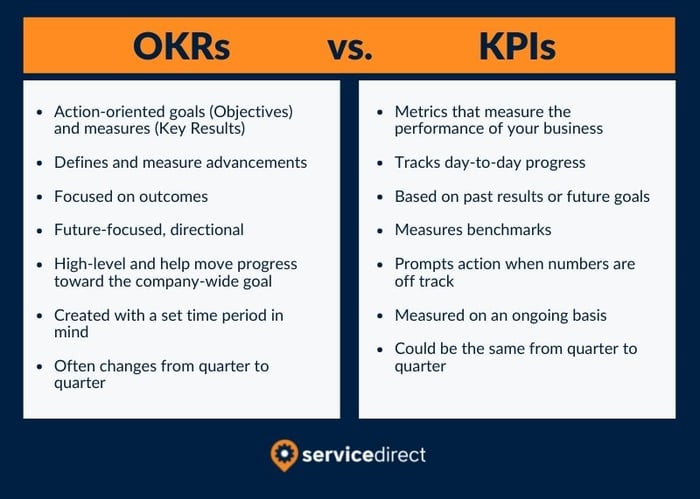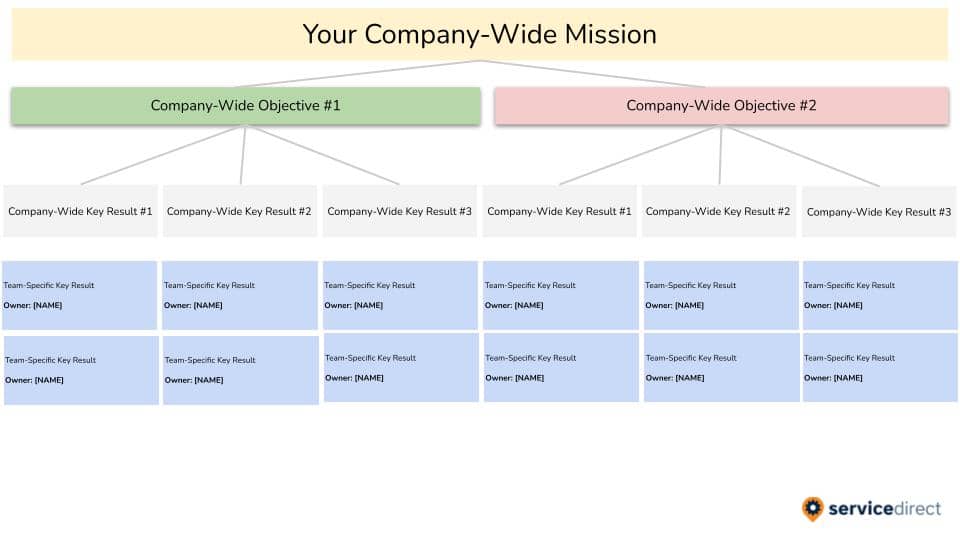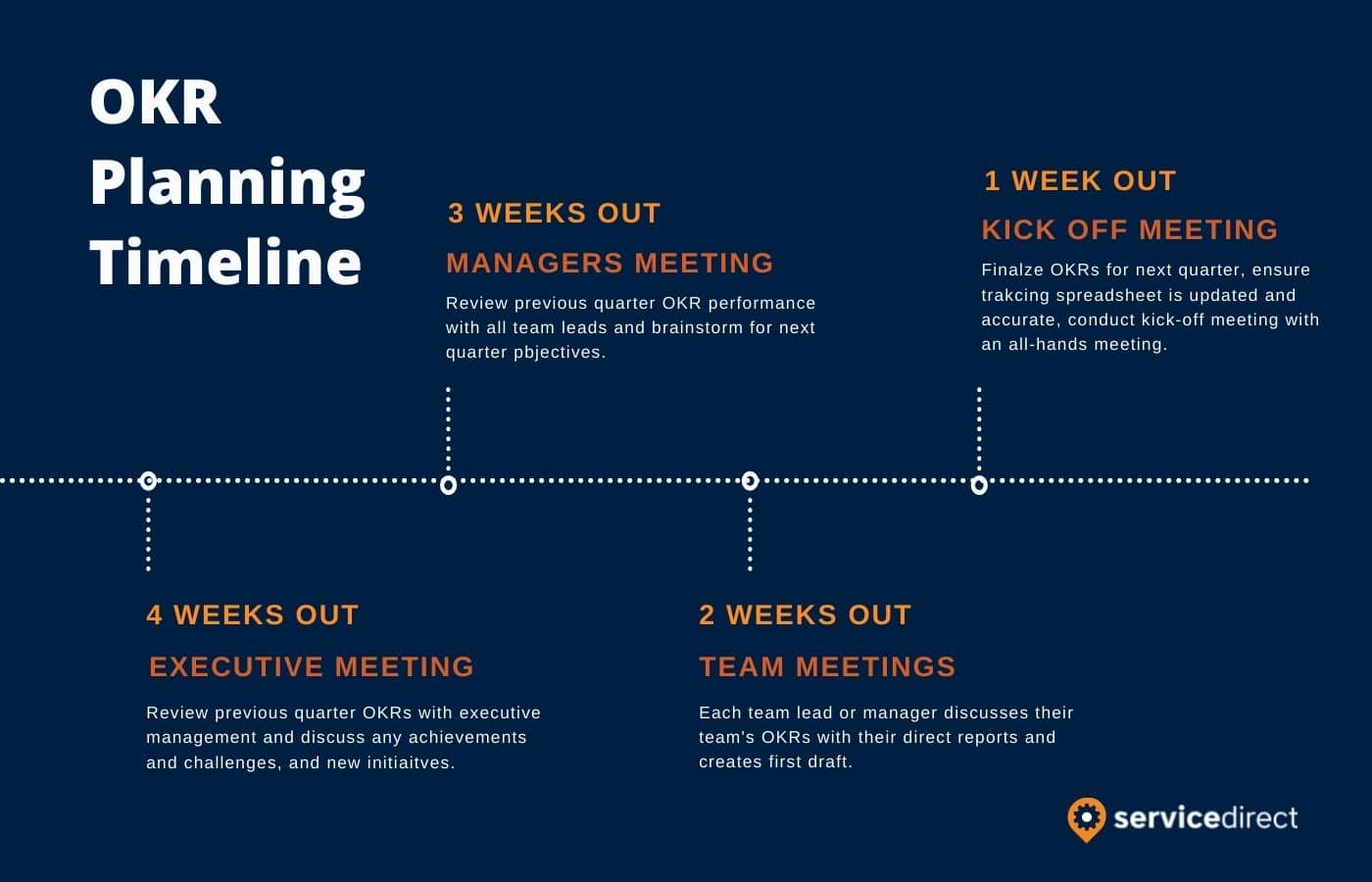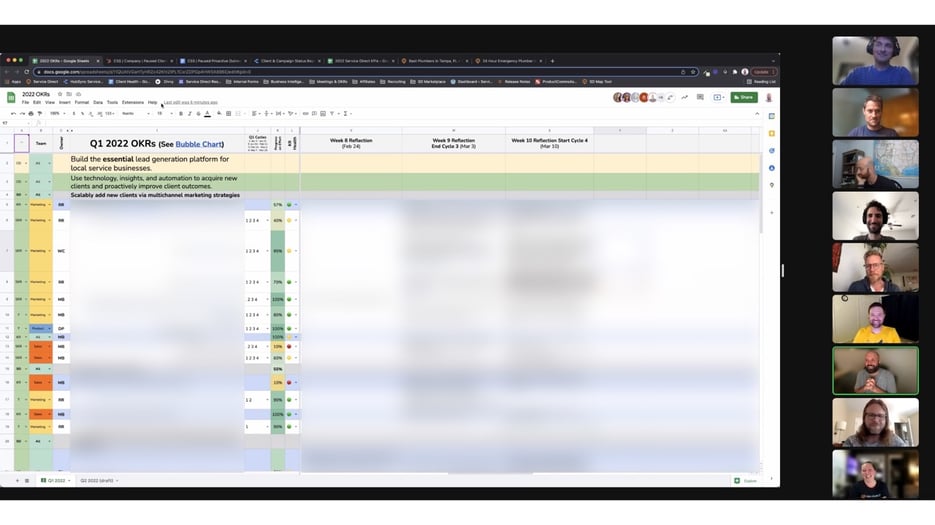OKR Planning: 12 Tips for Small Businesses
As a growing small business here at Service Direct, we spent many years trying to outline a goal-planning strategy that worked for us.
Through much trial and error, as well as a headache or two, we determined that the OKR system fit with our business style.
Since 2017, we have been using OKRs—objectives and key results—to set and achieve goals. But it hasn’t been all smooth sailing from the outset of our OKR journey—initially, we made more mistakes than not.
Now, however, we use this methodology daily to boost individual productivity, team collaboration, and company growth. In this blog, we will outline the basics of OKR strategic planning and provide some examples of OKRs.
As you dive into 2025 and are thinking about planning goals for the new year, take a look at what we learned from setting our own goals!
THE OKR methodology
Before we dive into how to write OKRs, it's important to understand the history behind the OKR acronym.
The OKR methodology was originally developed by Andy Grove at Intel, who then taught the concept to John Doerr, an early Google investor. The rest is history.
OKRs provide a flexible template for goal setting that is molded to fit any company’s needs. All while still providing an effective framework to get those goals completed.
.jpg?width=1200&name=OKR%20Framework%20Diagram%20(1).jpg)
The OKR goal-setting framework pairs the objectives you want to achieve with the key results you’ll use to measure progress. This directly ties your goals to your team's day-to-day work.
OKRs focus on results rather than processes, which promotes creative thinking and flexibility. With an understanding of company-wide objectives, and with specific results in mind, teams can collectively shape their work.
That's why OKRs are set while thinking of the long-term goals for your company while also connecting them to everyday work.
To best connect your big-picture OKRs with the day-to-day work, you will want to think of your OKRs as cascading. That means working down from the company-wide goal to build out smaller OKRs for teams.
This ensures every employee has work to do that contributes to the company-wide goal. When employees connect their daily work to the big-picture goals of the company, their motivation doubles, which leads to an increase in productivity.
The Difference Between OKRs and KPIs
People often get Objective-Setting confused with Key Performance Indicators (KPIs). Understanding OKR vs KPI was one of our first challenges as well.
Initially, we set our OKRs with a KPI-based mentality. For example, we would set an objective like "we want to see X results in a given quarter." If we didn’t reach that specific number we weren’t sure whether to mark the project complete. This is not an effective way to think about OKRs.
What We Learned. OKRs should focus on the projects and initiatives that the team has agreed are most important rather than focusing on a single specific number or result. By taking the pass-or-fail aspect out of the goal-setting process, the team can focus on the bigger picture.
Thinking about and tracking KPIs is important, but we recommend tracking them separately from OKRs.

Objectives and Key Results Example
To understand how you can boost your company’s productivity, we’ll provide a basic OKR example.
For this OKR example, picture a small home service business like a plumbing company. The structured framework that OKRs provide can be beneficial for small businesses such as these.
.jpg?width=791&height=445&name=Plumbing%20OKR%20Diagram%20(1).jpg)
Let’s dive into the example: The Objective is the plumbing company’s overall goal. In this example, the Objective is to hire an additional plumber by the end of the quarter. What must they do to achieve that goal?
They need to hit certain Key Results, including seeing an increase in lead volume and an increase in customer referrals.
There are specific tasks that the plumbing company can do to hit its Key Results, including updating its website, launching a customer satisfaction campaign, and partnering with a lead generation company that has a high lead volume in their area (like Service Direct).
By defining and outlining these Objectives and Key Results, this plumbing company is set up for success in the coming quarter. Plus, their employees will know exactly what it is they must do to move the company forward.
OKR PLanning: Secrets To Success
These are the 12 lessons we have learned from years of OKR goal planning. From leadership buy-in to goal visibility and project breakdown, these are the top things we think you should know about OKR management.
#1 - Make it Visual
Originally, we tracked OKRs in documents or established them verbally. This made it challenging to visualize what exactly we as a company are working toward, particularly for employees not involved in the planning process from start to finish.
What We Learned. Individuals need to understand how their work is feeding directly into our collective, shared company Objectives. To do that, we have an OKR bubble chart that very clearly helps teams see the big-picture view of how each Key Result feeds into an Objective.
 #2 - Get Buy-In From All Teams
#2 - Get Buy-In From All Teams
When we first began using OKRs our company was still very small and very busy. This meant that some people were updating OKRs regularly while others were only updating them at the end of each quarter.
This made it difficult for leadership to see the overall picture of progress, which prevented both intervention and further planning.
What We Learned. Over the years we have found that all teams need to commit to the OKR process. The best way to ensure this is to have full leadership buy-in. This is important because we have many teams with overlapping quarterly goals that need to be able to monitor progress as the quarter unfolds.
#3 - Give Yourself Enough Time
It can be tempting to brainstorm, write up, and solidify OKRs as quickly as possible. We initially made the mistake of attempting to plan OKRs in a single meeting.
We soon realized that rushing to create OKRs often results in changing the strategy mid-quarter or missing the mark entirely.
What We Learned. Although the goal-planning process may seem highly time-consuming, you must settle on a timeline that works best for your company. Doing this ensures that OKRs are ultimately not a waste of time and that they produce results that keep the company moving forward.

#4 - Keep OKRs Specific and Time-Bounded
There is a natural inclination to lean toward more open-ended OKRs because it is less daunting and offers more flexibility.
In the past, we would make OKRs that were broad, such as “complete Project X,” which is not time-specific. With goals like that, we found that there wasn't enough direction and thus less guidance to complete them.
What We Learned. Establishing both specific timelines and clear wording for what each OKR should accomplish helps the team. We have found that setting goals like “launch bite-sized piece Y by March 1” was able to provide the direction to keep the team motivated. Plus, we all benefit from seeing progress little by little.
#5 - OKRs Are For Everyone
With traditional goal-setting techniques, team leaders and managers tend to take most of the control of the goals and progress.
When we first started using OKRs we naturally tended toward that traditional approach, but quickly found it did not work. For OKRs to be effective, every person—not just the company executives—needs to be invested in the achievement of Key Results.
What We Learned. Every individual is necessary for successful OKR planning and completion. Leadership should get regular progress updates from the individuals they supervise and managers should regularly discuss OKR progress with individual contributors.
#6 - Plan Across Teams
In the past, when it came to OKR planning and development, each team would create their quarterly goals in a vacuum. They would plan their quarter based on what they felt was most important.
This ended up slowing down the company as a whole as teams tackled different issues rather than focusing on overlapping goals for the company.
What We Learned. Collaboration is extremely important when it comes to creating quarterly goals that work toward the improvement of the company as a whole. Objectives are often dependent on multiple teams, so to ensure goals are effectively planned and achieved, cross-team planning is essential.
#7 - Make Sure Everyone Is Using The Same OKR Tracker
![]()
Initially, we had teams working across many different platforms—some in Asana, some in a spreadsheet, some in a document, etc. This resulted in teams focusing solely on their OKRs rather than the company-wide goals. This also required teams to set up extra meetings and communication channels if they needed updates from one another.
What We Learned. You must have a single source of truth for OKR tracking. Not only can employees stay up to date on important OKR metrics, but people can also figure out who to contact with questions regarding objectives or key results.
#8 - Meet Regularly and Often (We Suggest Weekly)
It's up to you to determine how often stakeholders should meet to update the company on goal progress. We have figured out a meeting schedule and time that works for everyone involved, but it took some time.
This took some trial and error, so don't be afraid to make adjustments if the meeting schedule isn't working.

What We Learned. Meetings are crucial to connecting across teams and reinforcing the collaboration element of OKR planning. Additionally, with goal planning, it is important to both celebrate wins and see where we are falling short. This allows us to understand what we need to do in the future to work toward achieving those Objectives.
#9 - Singular Ownership of KRs is Key
As previously mentioned, OKRs are the most successful when they are team-oriented. However, we've found that having a project with multiple owners is just as unproductive as having no owners.
What We Learned. While the entire team and company will need to be involved and invested in the OKRs as a whole, it’s important to have one single person with stated ownership over each KR. Having a singular owner responsible for reporting on the Key Results empowers that person to do what it takes to achieve the goal and encourages others to do the same.
#10 - Break Down Large Projects
In the past, we have mistakenly tried to tackle large projects in a single quarter. When we get excited and don’t think critically about how much time a large project will take, the team can start to feel frustrated or overwhelmed.
It's a sign that you've overstretched your goals if a project is still on your OKRs multiple quarters down the road.
What We Learned. It’s important to walk the line between realistically pushing the team toward a goal and unrealistically trying to achieve results that need more time. By breaking up large projects into smaller, more achievable Objectives and Key Results, we can keep the momentum going.
#11 - Less is More
It can be tempting to throw as many KRs as possible at the board and see what sticks when it comes to building quarterly goals. This quickly leads to overwhelmed teams and a lot of partially completed projects.
What We Learned. We have slowly become better at narrowing down our ideas to 2-3 of the most impactful things a team can work on over the quarter. It’s sometimes still difficult for us to pinpoint which KRs belong in that upper echelon of goals but with time they have become easier for us to identify.
#12 - Add A Curveballs Section
Unplanned things will inevitably come up during the quarter and priorities will sometimes shift based on other things. This leads to adjusting your OKRs to match your current priorities. Or you can simply add another line item to the list.
What We Learned. Plan for unplanned work by adding a curveballs section at the bottom of your tracking sheet to make any unplanned work more visible and to better understand why we didn't plan for it. Anything in curveballs should be critically assessed for level of importance and effort relative to existing OKRs.
In Conclusion
After nearly 10 years of goal planning with OKRs, we can comfortably say that the OKR method is an effective way to keep moving forward as a company. It is a learning process that has been extremely rewarding in both the short and long term.
Every quarter we move closer to our company-wide goals thanks to the OKRs we have set and will continue to establish. If you want to use OKRs to keep your company-wide progress strong and steady, the tips we have listed will help propel you toward the completion of your goals and a higher level of productivity.
Author's Note: This blog was originally published in March 2022 and has been updated to reflect current trends and data.
Related Content
- Small Business AI Tips to Make the Most of Limited Resources
- Pay Per Call FAQs: Your Top Questions Answered
- What We Do to Ensure Phone Lead Quality




